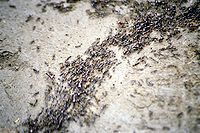
Photo from wikipedia
This paper presents a parameterisation and test of an algorithm to calculate distributions of the major nutrient cations between the solution and exchangeable phases of soil when cation exchange capacity… Click to show full abstract
This paper presents a parameterisation and test of an algorithm to calculate distributions of the major nutrient cations between the solution and exchangeable phases of soil when cation exchange capacity (c) may vary. Two contrasting soils were considered: a volcanic subsoil where c is dominated by variable-charge surfaces, and an alluvial silt loam topsoil with stable c. Experimental treatments consisted of applying either water or solutions of CaCl2, KCl, MgCl2, or NaCl. Solution concentrations of Ca2+, K+, Mg2+, and Na+ varied by up to two orders of magnitude, and were simulated well, particularly when using log10-transformed data. The ratios of the solution concentrations of K+, Mg2+, and Na+ to Ca2+ also were generally simulated well. However, the algorithm’s description of soil acidity needs further checking. For the variable-charge soil, cation concentrations were strongly influenced by fitted parameters associated with anion exchange. For the alluvial soil, fitted parameters had little influence, and the cation calculations were dominated by information gathered from the initial (equilibrium) distributions between phases. The algorithm has strong potential for forecasting changes in solution concentrations of the major nutrient cations, using relatively small amounts of fitting data.
Journal Title: Soil Research
Year Published: 2020
Link to full text (if available)
Share on Social Media: Sign Up to like & get
recommendations!